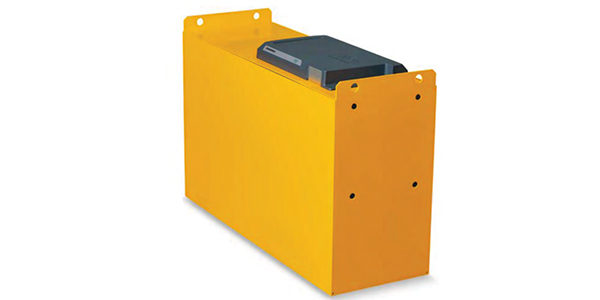A battery revolution?

Interest in lithium-ion (l-i) batteries for material handling applications has been growing over the last 10 years, but adoption of the technology in North America has been slow, to say the least.
That may be about to change in 2018.
There was no shortage of l-i battery and forklift products introduced to the market last year, and the trend promises to continue as prices come down and warehouse and distribution center managers turn a willing ear to companies touting the advantages of lithium-ion technology. Such trends put the battery market—which has seen few technology revolutions in the last 100 years—on the verge of a major change, with some industry experts predicting that l-i will take a good portion of the lift truck market, and in particular, away from traditional lead-acid batteries, in the not-too-distant future.
"Cell prices [for lithium-ion] are dropping and are targeted to be around $100 per kilowatt hour in two to four years, and at that point, it will be less of a sticker shock to [buyers]," says Porter Harris, chief technology officer at Romeo Power Technologies, a maker of high-performance battery packs for a range of applications, including forklifts and other electric vehicles. The cost of l-i batteries has been the biggest barrier to adoption in material handling, Harris adds, and as that comes down on a broader scale, more companies will be interested in hearing the return on investment (ROI) side of the story. Still, Harris and others stop short of putting a number to the share of market l-i may capture in the short term.
"Lithium will have a significant share of the lift truck market [in] 2018 leading into 2019," Harris says. "It really depends on how quick [manufacturers] are to incorporate the new technology into their vehicles, as it already makes business sense."
Harris and others say that converting to l-i batteries makes the most business sense for warehouses and DCs running two- and three-shift operations, as well as for those operating in cold temperatures, such as grocery and food/beverage organizations. Proponents say that's because l-i batteries last longer than traditional lead-acid batteries (with lifespans that are two to three times longer), have longer run times, are maintenance-free, and can withstand cold temperatures better than their lead-acid counterparts can—an appealing prospect for organizations that make heavy use of their lift trucks.
"For those in the know, [lithium-ion] is cost effective—especially when you look at what it offers you," says Harris, who adds that Romeo Power Technologies' Thunderpack C l-i battery pack is currently in use at several U.S. customers' facilities. "It's getting down to the price point it needs to be at in order to be widely adopted."
SAVE COSTS, ENHANCE PRODUCTIVITYThe cost equation has been one of the greatest drivers of change in the lithium-ion battery market over the last 18 to 24 months, says Mil Ovan, president and chief executive officer of Navitas Systems, maker of the 24-, 36-, and 48-volt Starlifter battery, now in use with about 20 to 25 customers nationwide. The cost of lithium-ion solutions has fallen only slightly in recent years—from three to four times the cost of lead-acid, down to two to three times the cost, Ovan says—but it's enough to make a difference to organizations running 16 and 24 hours a day with lead-acid batteries that require frequent changeouts and maintenance.
That's due to the increased productivity l-i provides. Ovan cites a study of Navitas' Starlifter battery pack that showed a 17-percent increase in the number of pallets moved per hour as a result of implementing the technology at a cold storage facility in upstate New York. Navitas partnered with forklift maker The Raymond Corp. for the testing, which was supported by a grant from the New York State Energy Research and Development Authority. The study also produced an ROI (return on investment) calculator to determine the payback period for a single lithium-ion-powered truck—which Ovan says is less than two years in two- to three-shift applications and in cold food/beverage production and distribution applications. "The biggest 'aha' is in these two- to three-shift applications, where you can prove significant uptick in productivity not available in lead-acid," says Ovan. "So if you're going to grow 15 percent next year, you can grow without [adding] more labor and forklifts. Now, the lithium battery pays for itself in 15, 16 months."
Increased efficiency goes hand in hand with those benefits, proponents also say. Organizations with large fleets of fork trucks save time and money by eliminating the maintenance protocols associated with lead-acid batteries: no more watering and ventilating required. This frees up warehouse space as well, as it also eliminates the need for a special battery room for maintenance and charging, according to Dr. Joachim Tödter, head of technology and innovation at material handling equipment maker Kion Group. Tödter adds that l-i batteries can be charged anywhere, and unlike their lead-acid counterparts, never need to be returned to a maintenance area.
Kion is a prime example of the growing interest in the advantages of l-i technology. Its North American group supplied a lithium-ion-powered fleet of forklifts, reach trucks, and tow tractors to the new Berkeley County, S.C., Volvo plant last year—the first of its kind in North America. Battery maker Flux Power offers another good example. The company announced late last year an additional $600,000 in purchase orders for its lithium-ion LiFT Pack batteries for Class 3 walkie pallet jacks. The orders come on top of previously announced orders for $500,000 worth of the equipment. Flux said it is increasing production levels for the Class 3 LiFT Packs as well as investing in research and development of its products for Class 1 and 2 lift trucks as a result of the growing interest.
COEXISTING TECHNOLOGIESDespite their advantages and growing use, lithium-ion batteries are not ideal for every situation and are still quite a few years away from widespread adoption, according to Tödter of the Kion Group.
"Not every customer will switch to lithium-ion batteries today," Tödter explains. "But ... the share of lithium-ion batteries will rise, and in the far future, the market for lead-acid batteries might be quite limited. But for the next [several] years, I expect a coexistence of both technologies."
Ovan agrees, adding that lead-acid batteries are still the right solution for many users.
"We don't see it as a zero-sum game," says Ovan. "Of course lead-acid will be around for a while—especially for one-shift applications and occasional use. But [for instances] where customers are intensifying operations—this is where lithium makes sense."
Related Articles

Copyright ©2024. All Rights ReservedDesign, CMS, Hosting & Web Development :: ePublishing